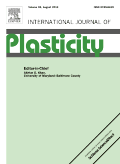
INTERNATIONAL JOURNAL OF PLASTICITY
Scope & Guideline
Transforming Understanding in Materials Engineering
Introduction
Aims and Scopes
- Plastic Deformation Mechanisms:
Research exploring the fundamental mechanisms of plastic deformation in various materials, including metals, alloys, and composites, often using advanced experimental techniques and computational modeling. - Multiscale Modeling:
Development and application of multiscale models to predict the mechanical behavior of materials under different loading conditions, emphasizing the relationship between microstructural features and macroscopic properties. - Material Design and Optimization:
Innovative approaches to design materials with tailored mechanical properties, focusing on achieving optimal strength-ductility balances through microstructural engineering. - Experimental Techniques:
Utilization of cutting-edge experimental methods, such as in-situ characterization techniques, to investigate material behavior under various loading scenarios and environmental conditions. - Computational Methods:
Advancements in computational techniques, including crystal plasticity finite element methods (CPFEM) and machine learning approaches, to simulate and predict the plastic deformation behavior in complex materials. - Hydrogen and Environmental Effects:
Studies investigating the impact of hydrogen and other environmental factors on the plastic behavior and failure mechanisms of materials, particularly in high-performance alloys.
Trending and Emerging
- High-Entropy Alloys and Complex Concentrated Alloys:
A significant increase in studies focusing on high-entropy and complex concentrated alloys, driven by their unique mechanical properties and potential applications in various industries, including aerospace and automotive. - Machine Learning and Data-Driven Approaches:
The integration of machine learning techniques into materials science research has gained momentum, with studies leveraging data-driven methodologies to enhance predictive modeling and material design. - Additive Manufacturing and 3D Printing:
Research exploring the plasticity behavior of materials fabricated through additive manufacturing techniques is on the rise, focusing on understanding the unique deformation mechanisms associated with these processes. - Hydrogen Embrittlement Studies:
An emerging focus on the impact of hydrogen on material performance, particularly in high-strength alloys, as researchers seek to understand and mitigate hydrogen-induced failures. - Multiscale and Coupled Modeling Approaches:
An increasing trend towards using multiscale and coupled modeling techniques to capture the complex interactions between microstructural evolution and macroscopic mechanical behavior. - Dynamic and In-Situ Characterization Techniques:
Research incorporating dynamic and in-situ characterization methods is gaining traction, providing real-time insights into the deformation processes and failure mechanisms of materials.
Declining or Waning
- Traditional Plasticity Models:
There has been a noticeable decline in studies focused solely on classical plasticity models without incorporating modern computational techniques or experimental validation, as researchers seek more comprehensive and integrative approaches. - Static Mechanical Testing:
Research relying predominantly on static mechanical testing methods has become less common, with a shift towards dynamic and in-situ testing methods that provide more relevant information about material behavior under realistic conditions. - Single-Scale Approaches:
The focus on single-scale models has decreased as the field progresses towards multiscale modeling approaches that account for interactions at different length scales, reflecting a broader understanding of material behavior. - Empirical Studies Without Theoretical Frameworks:
An observable reduction in empirical studies that lack robust theoretical or computational frameworks, as the community increasingly values studies that can provide predictive insights and deeper understanding of underlying mechanisms.
Similar Journals

Izvestiya of Saratov University Mathematics Mechanics Informatics
Empowering Scholars with Cutting-edge Research InsightsIzvestiya of Saratov University Mathematics Mechanics Informatics is a prominent open access journal published by Saratov State University, focusing on the interdisciplinary fields of mathematics, mechanics, and computer science. Established as an accessible platform for researchers since 2007, this journal fosters the dissemination of innovative research and advancements in computational mechanics, general mathematics, and mechanical engineering among others. Although currently categorized within the Q4 quartile rankings in various domains, including Computational Mechanics and Mechanics of Materials, it serves as a crucial resource for professionals and scholars aiming to explore emerging trends and methodologies. Operating out of Saratov, Russian Federation, this journal not only contributes to local academic discourse but also holds international relevance, welcoming submissions that push the boundaries of traditional research. Researchers, professionals, and students alike are encouraged to engage with the wealth of knowledge presented within its pages, reinforcing the journal’s role as a vital component in the ongoing development of these scientific fields.

International Journal of Mechanics and Materials in Design
Empowering Engineers with Knowledge in Mechanics and MaterialsInternational Journal of Mechanics and Materials in Design is a leading publication in the field of mechanical engineering and materials science, published by Springer Heidelberg. With an impressive impact factor, it holds esteemed rankings as Q1 in both Mechanical Engineering and Mechanics of Materials, and Q2 in Materials Science for the year 2023, solidifying its reputation as a significant contributor to the advancement of design methodologies. The journal focuses on the intersection of mechanics and materials, encouraging innovative research that addresses contemporary challenges faced in engineering disciplines. Researchers and professionals alike can benefit from accessing cutting-edge studies contributing to various applications, making it an invaluable resource for staying informed in this dynamic field. While the journal operates under a subscription model, its comprehensive reviews and high-quality original research foster a deeper understanding of material behavior and design principles, thus supporting the academic growth and professional development of its readers.
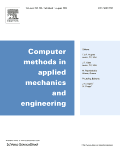
COMPUTER METHODS IN APPLIED MECHANICS AND ENGINEERING
Exploring Innovations at the Intersection of Engineering and Computation.COMPUTER METHODS IN APPLIED MECHANICS AND ENGINEERING, published by Elsevier Science SA, is a premier journal that has significantly contributed to the fields of computational mechanics, computer science applications, mechanical engineering, and the mechanics of materials since its inception in 1972. With an ISSN of 0045-7825 and an E-ISSN of 1879-2138, this journal is recognized for its rigorous peer-review process and is consistently ranked in the Q1 quartile across multiple categories, including Computational Mechanics and Mechanical Engineering. Its impressive Scopus rankings place it in the top tiers of its field, with a percentile ranking of 98th in Computational Mechanics. Researchers, professionals, and students will find the journal's comprehensive scope and high-quality articles invaluable for advancing their knowledge and practices at the intersection of engineering and computation. Although not an open-access journal, its impactful contributions to both theoretical and applied research make it an essential resource for anyone involved in these dynamic fields.
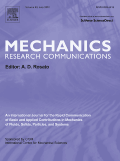
MECHANICS RESEARCH COMMUNICATIONS
Pioneering Research in Mechanics and Material ScienceMECHANICS RESEARCH COMMUNICATIONS, published by PERGAMON-ELSEVIER SCIENCE LTD, is a prestigious journal in the fields of Civil and Structural Engineering, Condensed Matter Physics, Materials Science, and Mechanical Engineering. With an ISSN of 0093-6413 and E-ISSN of 1873-3972, it has made significant contributions to the understanding and advancement of mechanics and materials since its inception in 1974. The journal is well-regarded in academia, holding a Q2 ranking across multiple categories as of 2023, and ranking in the 65th percentile for Mechanical Engineering. Researchers and professionals benefit from its peer-reviewed content, which includes a wide range of articles from fundamental research to applied technological developments. Although currently not an open access journal, it remains a vital resource for those focused on innovating within the engineering and materials science domains. With its established legacy, MECHANICS RESEARCH COMMUNICATIONS continues to shape the discourse in mechanics and engineering, making it essential reading for students and practitioners alike.
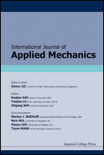
International Journal of Applied Mechanics
Exploring New Horizons in Materials ScienceThe International Journal of Applied Mechanics, published by World Scientific Publishing Co Pte Ltd, is a premier platform that serves the fields of materials science, mechanical engineering, and mechanics of materials. Located in Singapore, this journal has established itself as a crucial resource for researchers, professionals, and students, with its convergence of scholarly work from 2009 to 2024. Ranked in the Q2 category across notable disciplines, including Materials Science, Mechanical Engineering, and Mechanics of Materials, it reflects a strong commitment to publishing high-quality research that pushes the boundaries of knowledge in applied mechanics. Despite being a non-open access journal, its successful Scopus rankings, including an impressive rank of #151 in Mechanical Engineering, signify its substantial impact and recognition within the academic community. This journal not only aims to disseminate pioneering research but also to foster collaboration and innovation in the rapidly evolving landscape of applied mechanics.
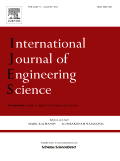
INTERNATIONAL JOURNAL OF ENGINEERING SCIENCE
Shaping the Future of Engineering Through Rigorous ResearchInternational Journal of Engineering Science, published by Pergamon-Elsevier Science Ltd in the United Kingdom, stands as a premier platform for pioneering research in the diverse fields of engineering and materials science. Since its inception in 1963, this journal has consistently demonstrated its commitment to advancing academic discourse, maintaining an impressive trajectory that positions it in the Q1 category across multiple engineering disciplines including Mechanical Engineering and Mechanics of Materials as of 2023. With notable Scopus rankings—placing it in the top 5% percentile for Mechanical Engineering and related fields—this journal attracts high-quality, impactful research designed for both industry practitioners and academic scholars. Although it does not currently offer Open Access options, its readership is enriched by comprehensive peer-reviewed articles, fostering a deeper understanding of complex engineering problems and innovative solutions. The International Journal of Engineering Science continues to be an invaluable resource for researchers, professionals, and students committed to pushing the boundaries of knowledge in engineering and materials science.
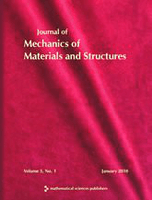
Journal of Mechanics of Materials and Structures
Advancing the Science of Materials and Structures.Journal of Mechanics of Materials and Structures, published by Mathematical Science Publishers, is a distinguished periodical in the field of Applied Mathematics and Mechanics of Materials. With the ISSN 1559-3959, this journal has been a pivotal platform since its inception in 2006, providing insights and advancements in the mechanics of materials and their structural applications. Operating out of the University of California, Berkeley, this journal not only boasts a respectable standing within its categories, ranking Q4 in Applied Mathematics and Q3 in Mechanics of Materials as of 2023, but it also serves a crucial role in fostering academic discourse among researchers, practitioners, and students alike. Although it does not currently offer open access, its contributions to the respective fields are invaluable, underscoring the relevance and importance of continued research in understanding material behavior and structural integrity. Whether investigating theoretical frameworks or engineering applications, the Journal of Mechanics of Materials and Structures remains an essential resource for anyone dedicated to the advancement of the science of materials and structures.
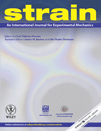
STRAIN
Transforming Understanding of Material BehaviorSTRAIN is a prestigious peer-reviewed journal published by WILEY, dedicated to advancing the field of mechanical engineering and mechanics of materials. With an ISSN of 0039-2103 and an E-ISSN of 1475-1305, STRAIN has been a pivotal resource for researchers and professionals since its inception in 1965. As of 2023, it holds a commendable categorization in the Q2 quartile rankings for both Mechanical Engineering and Mechanics of Materials, reflecting its significant contribution to the field and ranking in the top percentile of its category. STRAIN aims to disseminate high-quality, innovative research that enhances the understanding of strain phenomena and materials behavior under various conditions. Researchers seeking to publish cutting-edge studies will find a welcoming platform in STRAIN, where they can share their insights with a global audience committed to the evolution of engineering practices. Although it does not offer an Open Access option, its robust editorial standards ensure that all published works adhere to the highest levels of academic integrity and scientific rigor.

Forces in Mechanics
Unlocking the Secrets of Forces in MotionForces in Mechanics is a premier open access journal published by ELSEVIER that has carved out a significant niche in the realms of Mechanical Engineering and Mechanics of Materials. Established in 2020 and based in the Netherlands, this journal aims to disseminate high-quality research that explores the fundamental principles and applications of forces within mechanical systems. It operates under the ISSN 2666-3597, showcasing a dedication to transparent and accessible research for scholars around the globe. With a 2023 impact factor ranking placing it in the Q2 quartile for both Mechanical Engineering and Mechanics of Materials, the journal is recognized for its contributions to the field, evidenced by its Scopus ranking—285th in Mechanical Engineering and 184th in Mechanics of Materials, placing it in the 57th and 53rd percentiles, respectively. The journal publishes original research articles, reviews, and technical notes, catering to a diverse audience including researchers, practitioners, and students who are keen to advance their knowledge on the dynamics of forces in mechanical contexts. As it converges from 2021 to 2024, Forces in Mechanics remains committed to providing a platform for innovative research and critical discourse, ensuring that all published work is freely available to the global community.
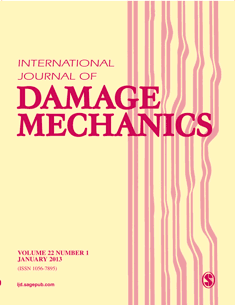
INTERNATIONAL JOURNAL OF DAMAGE MECHANICS
Driving Excellence in Damage Mechanics ResearchINTERNATIONAL JOURNAL OF DAMAGE MECHANICS, published by SAGE PUBLICATIONS LTD, stands as a pivotal peer-reviewed platform contributing to the fields of damage mechanics, computational mechanics, and materials science. With its ISSN 1056-7895 and E-ISSN 1530-7921, this esteemed journal has charted an impressive trajectory since its inception in 1992 and continues to influence the academic community through its high-quality research outputs. Recognized for its excellence, the journal has consistently ranked in the Q1 quartile across various categories including Computational Mechanics and Mechanical Engineering in 2023, reflecting its critical impact in these domains. It has attained an outstanding Scopus rank of #7/89 in Computational Mechanics, positioning it within the top tier of journals in the engineering discipline. The journal's commitment to advancing knowledge is further underscored by its broad scope that attracts innovative research, making it an essential resource for researchers, professionals, and students alike. Though it operates under a traditional subscription model, readers are encouraged to access its wealth of information, which is instrumental in promoting scholarly communication and driving forward the frontiers of damage mechanics.